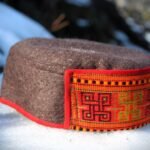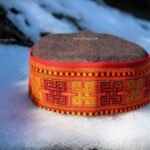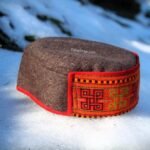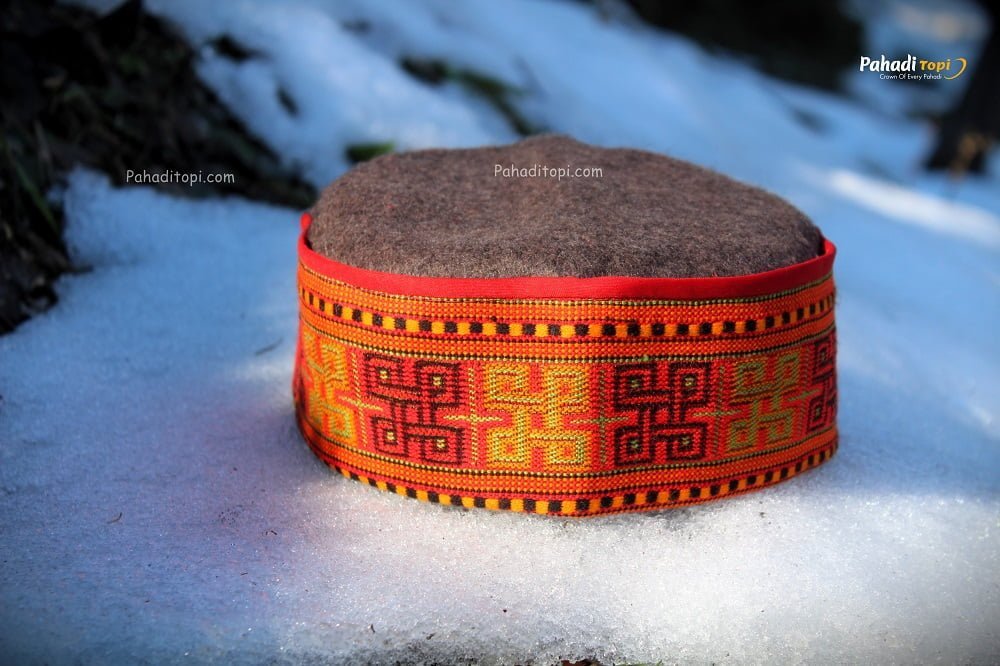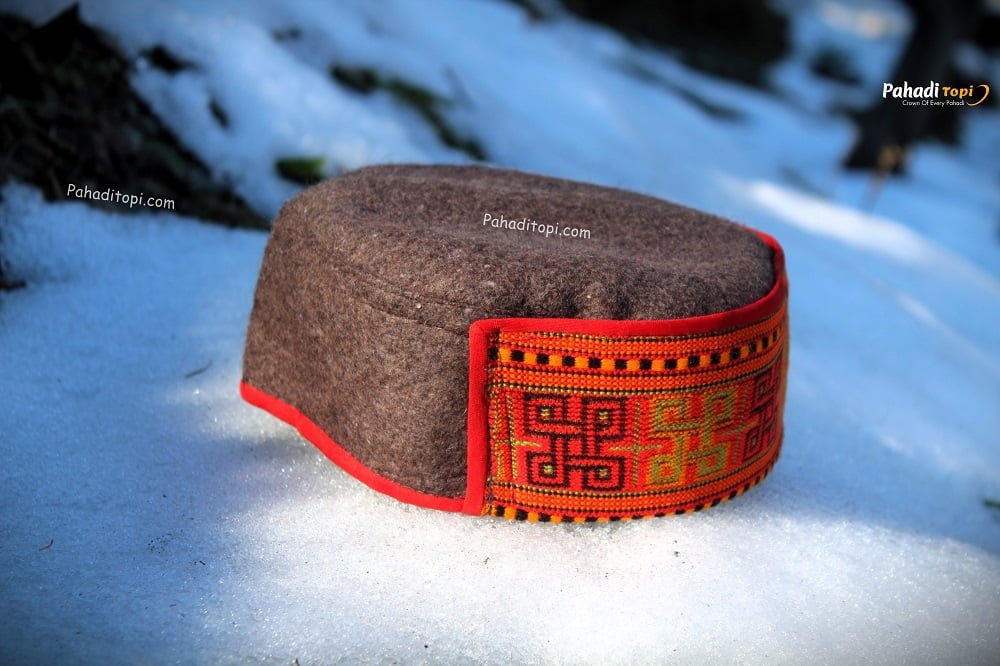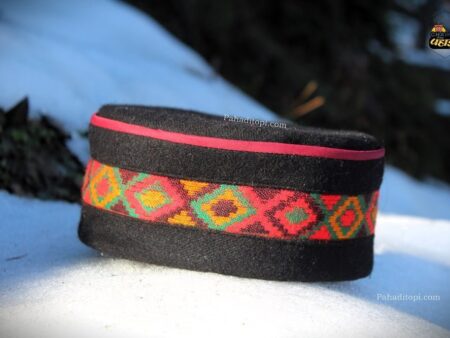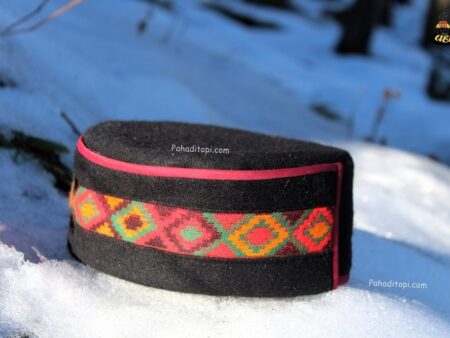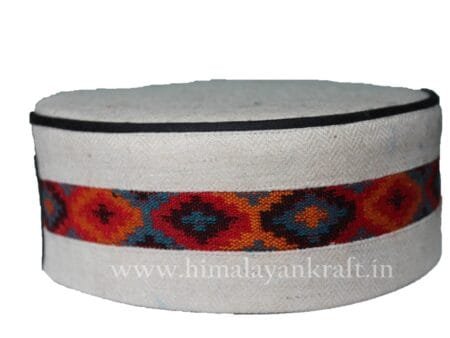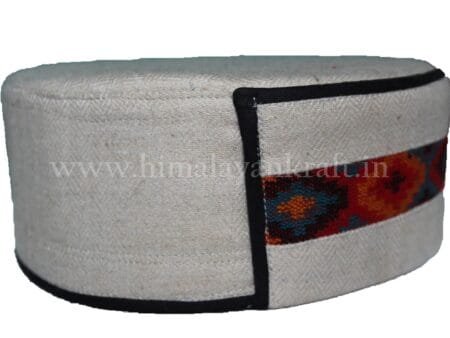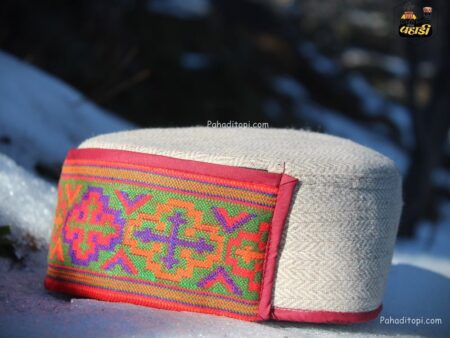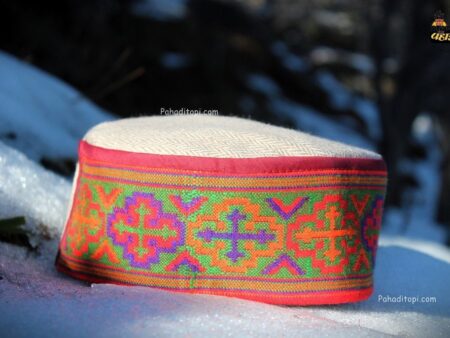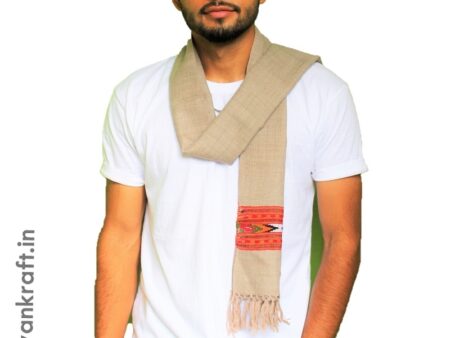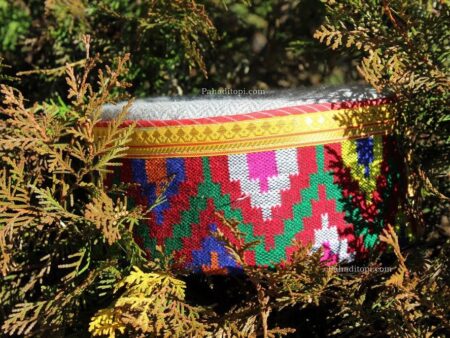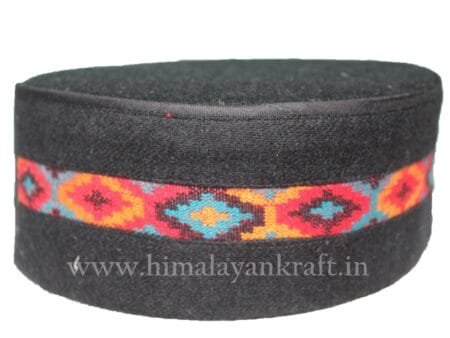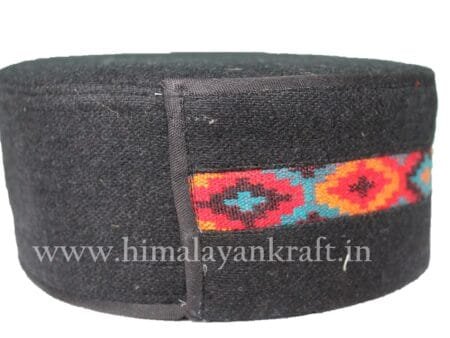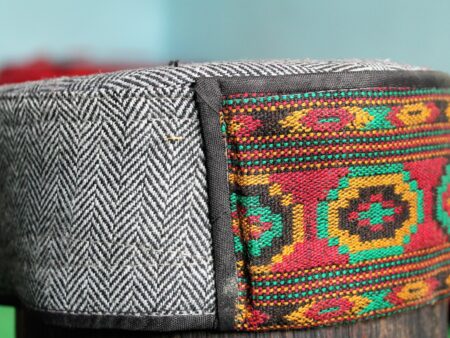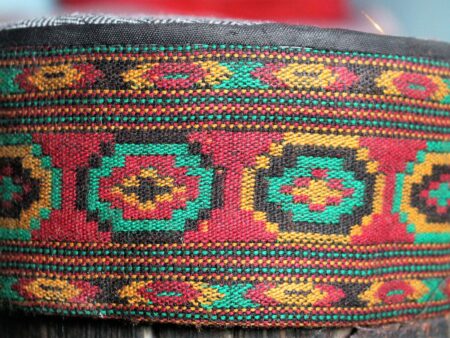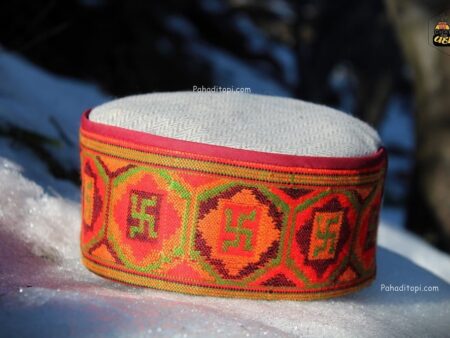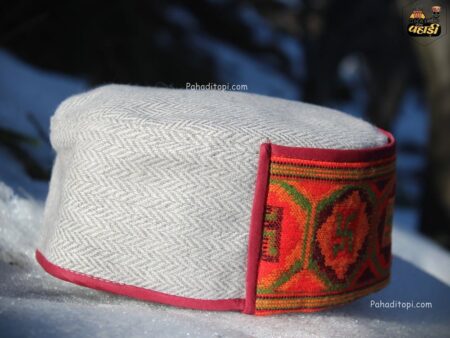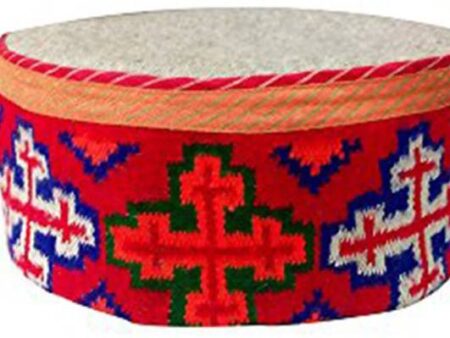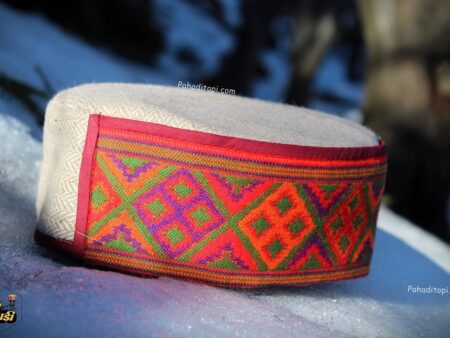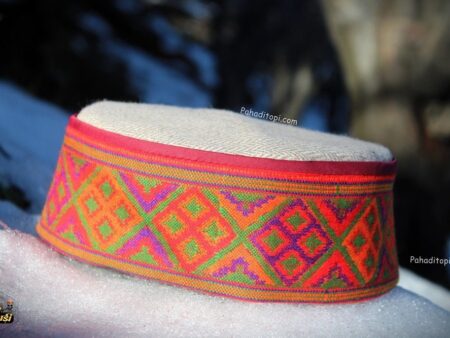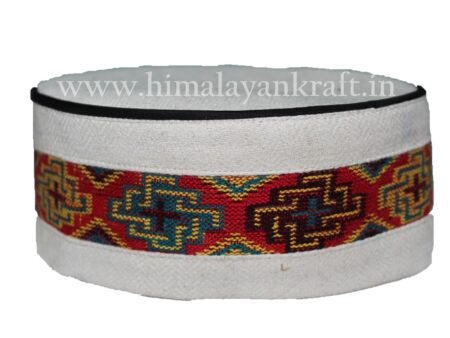Handmade Pahadi Cap – Authentic Topi from Himachal
₹650.00 Original price was: ₹650.00.₹260.00Current price is: ₹260.00.
- Himachali caps, adorned with intricate handcrafted designs, symbolize the authenticity of Himachali culture.
- Their unique conical shape, often made from wool or felt, sets them apart as an iconic symbol of the region’s heritage.
- Each cap bears distinctive motifs and colors representing different communities and traditions, showcasing the diversity of Himachal Pradesh.
- Wearing a Himachali cap not only exhibits pride in one’s Pahadi identity but also reflects the rich cultural heritage passed down through generations.
- These caps serve as a tangible link to the past, preserving centuries-old craftsmanship and traditions, making them a cherished symbol of Himachali pride and identity.

Handmade Pahadi Cap - Authentic Topi from Himachal
₹650.00Original price was: ₹650.00.₹260.00Current price is: ₹260.00.Request a Call Back
- Size Guide
Size Guide
Size Chest Waist Hips XS 36 28 34 S 38 30 36 M 40 32 38 L 42 34 40 XL 44 36 42 2XL 46 38 44 All measurements are in INCHES
and may vary a half inch in either direction.
No. Cms Inches Size 3 50 19.5 2XS 4 51 20 XS 5 52 20.5 S 6 53 21 M 7 54 21.5 L 8 56 22 XL All measurements are in INCHES
and may vary a half inch in either direction.
Product Lenght Width Shawl 80 40 Stole 80 30 Muffler 48 12 Lohi/Loi 100 50 All measurements are in INCHES
and may vary a half inch in either direction.
- Delivery & Return
Delivery
We ship to all States of India, And Also To Internationally. All orders are shipped with a Amazon, Delhivery, DTDC and Ecom Courier Partners Always free shipping for orders over INR500 in India. During sale periods and promotions the delivery time may be longer than normal.Return
himalayankraft.in will accept exchanges and returns of unworn and unwashed products only for Defective and Wrong Product Sent. All Return and Exchange can be happen within 5 days of the date of purchase (2 days during the sales period), on presentation of the original till receipt at any store where the corresponding collection is available within the country of purchase. Your return will usually be processed within a week to a week and a half. We’ll send you a Return Notification email to notify you once the return has been completed. Please allow 1-3 business days for refunds to be received to the original form of payment once the return has been processed.Help
Give us a shout if you have any other questions and/or concerns.Email: himalayankraft@gmail.comPhone: +91 - 9459500283 - Ask a Question

Handmade Pahadi Cap - Authentic Topi from Himachal
₹650.00Original price was: ₹650.00.₹260.00Current price is: ₹260.00.Ask a Question
The Himachali Pahadi Cap, an emblematic accessory, stands as a significant cultural symbol in the vibrant tapestry of Himachal Pradesh. Rooted deeply in the traditions of the region, this traditional woolen topi, known locally as the “Pahari Topi,” showcases the rich history and heritage of the Himachali people. The origins of this cap date back centuries, with its design evolving to reflect the cultural and environmental aspects unique to the Himachal region.
The Himachali Pahadi Cap is more than just an article of clothing; it represents the identity and pride of the Himachali people. Traditionally worn by men, the cap is an essential part of the traditional attire during festivals, ceremonies, and daily life. The cap is often adorned with intricate patterns and vibrant colors, each symbolizing different aspects of the local culture and beliefs. For instance, the colorful bands and motifs often depict local flora and fauna, religious symbols, or elements from folklore, making each cap a unique piece of art.
Predominantly worn in regions such as Kullu, Kinnaur, and Chamba, the Himachali Pahadi Cap varies slightly in design and color, reflecting the diverse cultures within Himachal Pradesh. In Kullu, for example, the cap is typically woven with bright, eye-catching colors and complex patterns, while in Kinnaur, it often features a more subdued palette with geometric designs. Despite these regional differences, the cap universally signifies dignity, respect, and the warm hospitality synonymous with the Himachali people.
The role of the Himachali Pahadi Cap in traditional attire cannot be overstated. It complements the typical Himachali dress, which includes woolen shawls, churidars, and intricately embroidered jackets, creating a harmonious and culturally rich ensemble. The cap, thus, is not just an accessory but a vital component that completes the traditional look, embodying the essence of Himachali heritage and identity.
Historical Significance and Evolution
The Himachali Pahadi Cap, a traditional woolen topi, holds a rich historical significance that traces back to ancient times. This distinctive headgear has been an integral part of the cultural fabric of Himachal Pradesh for centuries, signifying the region’s unique heritage and identity. The origins of the Himachali Pahadi Cap can be linked to ancient tribal societies who inhabited the mountainous terrains of Himachal Pradesh. These early communities crafted the cap using locally sourced wool, which provided essential warmth and protection against the harsh climatic conditions.
Over the centuries, the design and usage of the Himachali Pahadi Cap have undergone significant evolution, influenced by various dynasties, local tribes, and cultural exchanges. During the reign of the Katoch dynasty, which ruled parts of present-day Himachal Pradesh, the cap gained prominence as a symbol of regional pride. The intricate designs and vibrant colors of the cap reflected the artistic sensibilities and craftsmanship of the period. The influence of the Mughal Empire also left an indelible mark on the cap’s design, introducing new patterns and decorative elements.
Local tribes, such as the Gaddis and Kinnauris, have played a pivotal role in preserving and perpetuating the tradition of wearing the Himachali Pahadi Cap. Each tribe brought its unique touch to the cap, incorporating distinct motifs and embroidery styles that represent their cultural narratives. These variations in design not only highlight the diversity within Himachal Pradesh but also emphasize the cap’s significance as a cultural emblem.
Prominent historical figures have also contributed to the cap’s cultural prominence. Raja Bhuri Singh of Chamba, known for his patronage of the arts, is often credited with popularizing the cap during his reign. Additionally, the cap became a symbol of resistance during the British colonial period, worn by freedom fighters and regional leaders to assert their cultural identity and defiance. This historical context underscores the Himachali Pahadi Cap’s evolution from a practical accessory to a powerful cultural symbol, embodying the resilience and heritage of the Himachali people.
Material and Craftsmanship
The Himachali Pahadi Cap, a quintessential representation of Himachal Pradesh’s rich cultural heritage, is primarily crafted from high-quality woolen fabric. Wool, being an excellent insulator, offers warmth and comfort, making it the ideal material for headgear in the chilly Himalayan climate. The wool is often sourced locally, supporting sustainable practices and the regional economy.
The craftsmanship of these caps is a testament to the skill and dedication of Himachali artisans. Creating a single Himachali Pahadi Cap is a labor-intensive process that involves meticulous attention to detail. Artisans employ traditional weaving techniques that have been passed down through generations. These techniques ensure that each cap is not only functional but also a work of art.
Embroidery is a distinctive feature of the Himachali Pahadi Cap. Intricate patterns, often inspired by nature and local folklore, adorn the caps. These designs are typically hand-embroidered using vibrant, colorful threads, adding to the cap’s aesthetic appeal. Common motifs include flowers, geometric shapes, and even symbolic representations of local deities.
The colors and patterns of the caps can vary significantly, often indicating the wearer’s region or community within Himachal Pradesh. For instance, the Kullu cap is known for its bright, multi-colored bands, while the Kinnauri cap often features intricate, symbolic designs in a more subdued color palette. This regional differentiation adds a layer of cultural significance to the caps, making them not just accessories but also markers of identity.
Preserving the traditional methods of making the Himachali Pahadi Cap is crucial. These age-old techniques are not only a part of the region’s cultural heritage but also support the livelihoods of local artisans. As modern, machine-made alternatives become more prevalent, it is important to promote and sustain the traditional craftsmanship that makes each Himachali Pahadi Cap unique.
Different Types and Styles
The Himachali Pahadi Cap, a traditional woolen topi, is a significant emblem of Himachali culture. It comes in various types and styles, each reflecting the unique cultural essence of different regions within Himachal Pradesh. These caps are not just mere headgear but important cultural symbols that hold historical and social significance.
Among the different types of Himachali Pahadi Caps, the Kullu cap, Kinnauri cap, and Bushahri cap are the most prominent. The Kullu cap, known for its vibrant colors and intricate patterns, often features geometric designs and is typically adorned with a colorful band around the base. This cap is usually worn during festivals and special ceremonies, symbolizing joy and celebration.
The Kinnauri cap, on the other hand, is distinguished by its muted colors and elegant patterns. It often includes green as a prominent color, symbolizing the lush landscapes of the Kinnaur region. The Kinnauri cap is traditionally worn by the people of Kinnaur and is often seen during community gatherings and regional festivals. Its understated elegance makes it suitable for a wide range of occasions.
Another notable style is the Bushahri cap, which hails from the Bashahr region. This cap is characterized by its unique blend of colors and intricate embroidery, often including floral motifs. It is typically worn by the inhabitants of the Shimla district and is a common sight during local fairs and religious events. The Bushahri cap’s distinctive design sets it apart as a symbol of regional identity and pride.
The choice of cap style often depends on the occasion and the wearer’s regional affiliation. For instance, during weddings and traditional ceremonies, people might choose more elaborate and richly decorated caps, while simpler styles might be preferred for everyday wear. These caps are typically worn by men, though women also don them during certain cultural events and festivals.
Overall, the diversity in types and styles of Himachali Pahadi Caps showcases the rich cultural tapestry of Himachal Pradesh, with each cap telling a unique story of the region it represents.
Cultural and Social Importance
The Himachali Pahadi Cap, a traditional woolen topi, plays an essential role in the cultural and social fabric of Himachal Pradesh. This distinctive headgear is not merely a piece of clothing but a potent symbol that encapsulates the region’s rich heritage and social identity. It is a staple during various cultural events, including festivals, weddings, and community gatherings, where it is donned with pride by locals of all ages.
During festivals like Dussehra and Diwali, the Himachali Pahadi Cap is a common sight, worn by both men and women as they partake in celebratory activities. It serves as a unifying element, bringing people together in shared cultural expression. Weddings, too, see the cap take center stage, often being part of the groom’s attire, signifying respect and adherence to tradition. In such settings, the cap is not just an accessory but a statement of identity and belonging.
Moreover, the cap holds significant social importance. It is a symbol of pride for the people of Himachal Pradesh, reflecting their unique cultural heritage. Wearing the Himachali Pahadi Cap is a way of showcasing one’s roots and allegiance to the community. It fosters a sense of unity and collective identity among the people, acting as a visual marker of their shared history and traditions.
Locals often express deep emotional connections to the cap. As one resident of Kullu noted, “The Pahadi Cap is a part of who we are. It tells the story of our ancestors and keeps our traditions alive.” This sentiment is echoed throughout the region, where the cap is revered not just for its aesthetic appeal but for its cultural significance.
In essence, the Himachali Pahadi Cap is more than just a piece of traditional attire; it is a vital component of the social and cultural identity of Himachal Pradesh. Its presence at key life events and its role in community cohesion underscore its enduring importance in the lives of the people.
Modern-Day Relevance
The Himachali Pahadi Cap, a traditional woolen topi, holds significant relevance in contemporary fashion. In recent years, this cultural artifact has experienced a resurgence, seamlessly blending into modern fashion trends. Designers and brands have played a pivotal role in this revival. Notable fashion houses such as Sabyasachi and local Himachali designers like Kullu-based Manu Alpana have incorporated the Himachali Pahadi Cap into their collections, presenting it as a stylish accessory that transcends its cultural roots.
Among younger generations, the cap has garnered renewed interest. Millennials and Gen Z are increasingly drawn to fashion that reflects cultural heritage while also making a bold style statement. The Himachali Pahadi Cap, with its vibrant colors and intricate patterns, fits well into this ethos. It is not uncommon to see these caps paired with both traditional and contemporary outfits, from wedding attire to casual streetwear.
The balance between maintaining tradition and adapting to modern trends is delicately managed. While the fundamental design elements of the Himachali Pahadi Cap remain unchanged, subtle modifications in color schemes, materials, and embellishments cater to evolving fashion preferences. This adaptation ensures that the cap retains its cultural significance while appealing to a broader audience.
Moreover, social media has played a crucial role in popularizing the Himachali Pahadi Cap. Influencers and fashion bloggers frequently feature the cap in their posts, showcasing its versatility and cultural richness. This digital exposure has helped elevate the cap from a regional symbol to a fashionable accessory recognized on a global scale.
In essence, the Himachali Pahadi Cap’s modern-day relevance lies in its ability to bridge the gap between tradition and contemporary fashion. It stands as a testament to the enduring appeal of cultural artifacts, proving that with thoughtful adaptation, traditional items can find a place in the modern wardrobe.
The Himachali Pahadi Cap, a quintessential symbol of cultural heritage, confronts several challenges in its preservation. One of the primary issues is the declining interest among the younger generation. Modern fashion trends and a preference for contemporary headgear have led many youths to overlook this traditional woolen topi. The allure of Western and urban styles often overshadows the cultural significance of the Pahadi Cap, contributing to its diminished presence in everyday wear.
Another significant challenge is the competition from mass-produced goods. The global market is inundated with inexpensive, machine-made alternatives that mimic the design of the Himachali Pahadi Cap but lack its authenticity and craftsmanship. These mass-produced items are often more accessible and affordable, drawing consumers away from the traditional, handcrafted versions. This shift not only affects the artisans’ livelihoods but also jeopardizes the continuation of the cap-making craft itself.
Globalization further exacerbates these challenges by introducing a variety of cultural influences that dilute the unique identity of the Himachali Pahadi Cap. As global cultures intermingle, the cap’s distinctiveness faces the risk of being overshadowed by more dominant fashion trends. This cultural homogenization poses a threat to the preservation of such unique ethnic symbols.
In response to these challenges, various efforts are underway to preserve and promote the Himachali Pahadi Cap. Local communities play a crucial role by organizing cultural festivals and events that showcase traditional attire, including the cap, thereby fostering a sense of pride and belonging among the younger generation. Additionally, government initiatives aim to support artisans through subsidies and training programs that enhance their skills and market reach. NGOs also contribute by raising awareness about the cultural significance of the Pahadi Cap and facilitating platforms for artisans to sell their products both locally and internationally.
These combined efforts are essential in safeguarding the tradition of the Himachali Pahadi Cap, ensuring that it continues to be a vibrant symbol of Himachal Pradesh’s rich cultural heritage. By addressing the challenges and leveraging preservation initiatives, there is hope for this iconic woolen topi to be cherished by future generations.
Conclusion and Future Prospects
The Himachali Pahadi Cap, often referred to as the traditional woolen topi, stands as a significant cultural symbol of the Himachal Pradesh region. Throughout this blog post, we have delved into its historical origins, intricate craftsmanship, and its role in the daily and ceremonial life of the Himachali people. This cap, with its unique designs and vibrant colors, not only exemplifies the rich heritage of the region but also embodies the identity and pride of its wearers.
As we reflect on the importance of the Himachali Pahadi Cap, it becomes evident that preserving this tradition is crucial for maintaining the cultural fabric of Himachal Pradesh. The cap is more than an accessory; it is a repository of the region’s history, artistry, and social values. However, this tradition faces several challenges, including the encroachment of modern fashion trends and the dwindling number of artisans skilled in the traditional methods of cap-making.
Efforts are being made to keep this cultural wear alive. Initiatives by local governments, non-profits, and artisan cooperatives aim to promote the Himachali Pahadi Cap through cultural exhibitions, tourism, and educational programs. These efforts not only provide a platform for the artisans but also educate the younger generation about the cap’s cultural significance. Furthermore, there is a growing market for traditional crafts among ethically conscious consumers, which can provide an economic incentive to sustain this craft.
As readers, supporting traditional crafts like the Himachali Pahadi Cap can make a substantial difference. By appreciating and purchasing these handcrafted items, we contribute to the preservation of cultural heritage and support the livelihoods of artisans. In a world increasingly dominated by mass-produced goods, the Himachali Pahadi Cap serves as a reminder of the beauty and value of handcrafted cultural artifacts. Let us cherish and sustain this tradition for future generations.
| Dimensions | 20 × 15 × 8 cm |
|---|---|
| Size | 5, 6, 7, 8, 9 |
| Design | Swastik, Plus, Stars, Flower, Flower Red, Star Red, Akhroti, Black Arrow, Swastik Red, Multicolor, Arrow Multi, Kingri, Arrow Yellow |
- Women Collection
- Kullu Jackets
- Jackets
- Weaverise
- HandCraft Collection
- Men's Jackets
- New Arrival Stoles
- Himachali Caps
- Mufflers
- DIY Art
- Himalayan Gems
- New Arrivals
- Woman
- HimalayanKraft Caps (Topi)
- Clothing & Apparel
- Hand Knitted
- Kumbh 2025 Special
- Child Collection
- Angora Wool
- Combo Deals
- test
- Women
- Featured Product Collection
- Shawls
- Kullu Handloom
- Shiv Special Caps
- Sport & Outdoor
- Girls Collection
- Winter Collection
- New Arrival
- HimalayanKraft Woolen Gloves
- Uncategorized
- Men
- Men Collection
- Top Selling
- Kids Wear
- Scarf Collection
- Socks Collection
- Stole
- Meditation Shawl
- G.I. Patented Art
- Woolen Tie collection
- Footwear
- Hoodies
- Men's Shawl Online
- Best Handloom Product
- Cap Shawls Women Winter
- Check Shawls Women
- Fabric Himalaya
- Geographical Indicator
- Handloom Shawls Women
- Himachal Clothes Women
- Himachal Scarf
- Himachal Shawl
- Himachal Shawls Women
- Himalayankraft Shawl
- Kullu Handloom
- Kullu Pure Wool Shawl Women
- Kullu Shawl
- Kullu Shawls Women Wool
- Kullu Shawl Women
- Light Shawl Women
- Pure Woolen Shawl
- Pure Woolen Shawl Women
- Pure Woollen Shawl Women
- Pure Wool Shawl Women
- Reversible Shawl Women
- Sawal Women Winter
- Scarf Girl
- Scarfs Women Wool
- Scarves Shawls
- Shawl With Kullu Border
- Soft Shawl Women Winter
- Stall Women Winter
- Stall Women Winter Latest
- stole and shawl
- Stoll Woolen Women
- Thick Woolen Shawl Women
- Warm Shawl
- Warm Shawl Women
- White Scarf Girl
- Winter Shawl Women Stylish
- Woolen Scrafs Women's
- woolen shawl stole
- Woolen Shawl Women
- Woolen Stole
- Woollen Scarves Women
- Wool Scarf
- Wool Shawl Women
- Wrap Shawls
Related Products
- The Himachali Cap, a distinctive symbol of Himachali culture, features intricate patterns unique to the region.
- Handcrafted with traditional techniques, each cap reflects the authenticity of Pahadi craftsmanship.
- Known for its vibrant colors and geometric designs, the cap represents the rich heritage of Himachal Pradesh.
- Worn proudly during festivals and ceremonies, the Himachali Cap signifies regional pride and identity.
- The cap’s unique shape and style make it an iconic accessory in Pahadi attire, symbolizing the mountainous terrain and lifestyle
Product Name :- Kullu Cap (Topi)- Kullu Traditional Cap with Beautiful Embroidery- White Colored
Color-:- White
Size- 5, 6, 7, 8,
Fabric:- Wool
Specifications:-
- 100% Pure Woolen
- 100% Pure Hand Woven Embroidery
- 100% Hand Made
- Designed keeping in mind the changing fashion trends.
- These Wool Caps are soft, Warm and imperial in looks it has real pride of today’s craftsman.
- Beautiful Malana Cap give you a glamorous and traditional look to the wearer and make your moments special and memorable.
Product Name :- Kullu Cap (Topi)- Kullu Traditional Cap with Beautiful Embroidery- White Colored
Color-:- White
Size- 5, 6, 7, 8,
Fabric:- Wool
Specifications:-
- 100% Pure Woolen
- 100% Pure Hand Woven Embroidery
- 100% Hand Made
- Designed keeping in mind the changing fashion trends.
- These Wool Caps are soft, Warm and imperial in looks it has real pride of today’s craftsman.
- Beautiful Malana Cap give you a glamorous and traditional look to the wearer and make your moments special and memorable.
In stock
- Symbolizes Himachali cultural heritage, embodying centuries of tradition and authenticity.
- Crafted with intricate designs and vibrant colors, each cap is a unique piece of art reflecting the diverse culture of Himachal Pradesh.
- Worn with pride by locals during festivals and special occasions, the Himachali cap is a symbol of identity and belonging in the Pahadi community.
- Its distinctive shape and embellishments distinguish it from caps found in other regions, highlighting its uniqueness.
- Passed down through generations, the Himachali cap carries the essence of Pahadi heritage, serving as a tangible link to the rich cultural legacy of the region.
- Pure Wool Shawl for warmth and elegance
- Soft and stylish Muffler for protection from the cold
- Hand-knitted Socks for cozy comfort
- Handcrafted by skilled Himachali artisans
- Ideal for casual and formal wear during winter
Immerse yourself in the rich cultural heritage of the Himalayan region with our exclusive Himachali Pahadi Topi Cap. Crafted with precision and inspired by the traditional headwear worn by the locals, this cap seamlessly blends heritage with modern style. Elevate your fashion game while paying homage to the vibrant culture of Himachal Pradesh.
Product Name :- Kullu Cap (Topi)- Kullu Traditional Cap with Beautiful Embroidery- Black Colored
Color-:- Black
Size- 5, 6, 7, 8,
Fabric:- Wool
Specifications:-
- 100% Pure Woolen
- 100% Pure Hand Woven Embroidery
- 100% Hand Made
- Designed keeping in mind the changing fashion trends.
- These Wool Caps are soft, Warm and imperial in looks it has real pride of today’s craftsman.
- Beautiful Malana Cap give you a glamorous and traditional look to the wearer and make your moments special and memorable.
Product Name :- Kullu Cap (Topi)- Kullu Traditional Cap with Beautiful Embroidery- Grey Colored
Color-:- Grey
Size- 5, 6, 7, 8, 9 , 10
Fabric:- Wool
Specifications:-
- 100% Pure Woolen
- 100% Pure Hand Woven Embroidery
- 100% Hand Made
- Designed keeping in mind the changing fashion trends.
- These Wool Caps are soft, Warm and imperial in looks it has real pride of today’s craftsman.
- Beautiful Malana Cap give you a glamorous and traditional look to the wearer and make your moments special and memorable.
- Reflects Himachali heritage with intricate embroidery and vibrant colors, embodying authenticity.
- Uniquely crafted with distinct patterns and designs, representing the diverse culture of the region.
- Symbolizes the rich history and traditions of the Pahadi people, encapsulating their identity.
- Handmade by skilled artisans, each cap carries a story of craftsmanship and dedication.
- Wearing the Himachali cap is not just a fashion statement but a proud display of Pahadi culture and tradition.
Product Name :- Kullu Cap (Topi)- Kullu Traditional Cap with Beautiful Embroidery- White Colored
Color-:- White
Size- 5, 6, 7, 8,
Fabric:- Wool
Specifications:-
- 100% Pure Woolen
- 100% Pure Hand Woven Embroidery
- 100% Hand Made
- Designed keeping in mind the changing fashion trends.
- These Wool Caps are soft, Warm and imperial in looks it has real pride of today’s craftsman.
- Beautiful Malana Cap give you a glamorous and traditional look to the wearer and make your moments special and memorable.
In stock
- Symbolizes the rich cultural heritage of Himachal Pradesh, embodying centuries-old traditions and craftsmanship.
- Crafted meticulously by local artisans using traditional methods, each cap is a unique piece of art, showcasing the region’s skilled craftsmanship.
- Its distinctive design and vibrant colors reflect the diverse landscapes and indigenous flora and fauna of the Himalayan region.
- Wearing the Himachali cap is not just a fashion statement but also a symbol of pride and identity for the people of Himachal Pradesh, connecting them to their roots and heritage.
- The Pahadi cap’s authenticity lies in its deep-rooted significance in Himachali society, serving as a cultural emblem passed down through generations, preserving the essence of Pahadi traditions.
Product Name :- Kullu Cap (Topi)- Kullu Traditional Cap with Beautiful Embroidery- White Colored
Color-:- White
Size- 5, 6, 7, 8,
Fabric:- Wool
Specifications:-
- 100% Pure Woolen
- 100% Pure Hand Woven Embroidery
- 100% Hand Made
- Designed keeping in mind the changing fashion trends.
- These Wool Caps are soft, Warm and imperial in looks it has real pride of today’s craftsman.
- Beautiful Malana Cap give you a glamorous and traditional look to the wearer and make your moments special and memorable.
In stock

